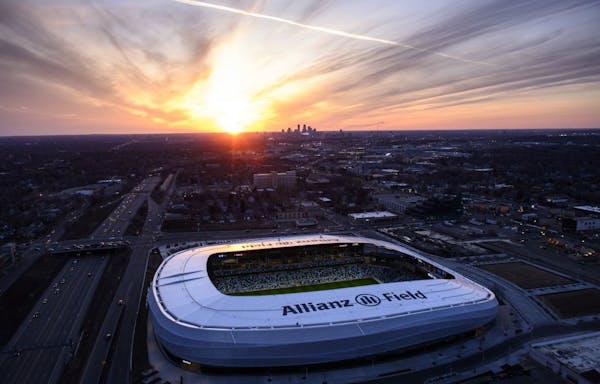The poets wrote that life imitates art rather than the other way around, and so it goes with Allianz Field's signature feature.
It truly may be, after all, a Wonderwall. Or just a wonderful wall of people.
Either way, the 2,920-capacity, safe-standing supporters' section rising behind the south-end goal will be loud, colorful and a defining experience for a sport that's all about fans uplifting their team.
"I actually walked to the top of it," United veteran defender Ike Opara said. "Kudos to whoever is going to go up there. It's going to be rocking for sure, but I'm scared of heights so it's too steep for me."
United Managing Director Bill McGuire and Kansas City architectural firm Populous, with lead designer Bruce Miller, wanted a wall of humanity that intimidates opposing goalkeepers. It now unofficially has assumed the name of British band Oasis' 1995 hit "Wonderwall," which United fans have sung together after victory since at least 2012.
Encompassing nearly 15 percent of the stadium's capacity, the section has no seats, with only rails to grasp. It ascends — at a steep 34.9 percent incline, according to the architect's math — seemingly right on top of friend or foe in the net below.
"Noise, if you're not ready for it, can change your game," United goalkeeper Vito Mannone said. "Communication's the main problem. You try to speak to your defenders and they can't hear from 5 yards away. You can waste your voice all 90 minutes."
Single-tiered and general admission only, the section will support from bottom to top the team's loudest, most devout fans. Most of them, but not all, will be from supporters' groups the Dark Clouds and the True North Elite.
Fans will sing and chant, stomp (the flooring is aluminum), wave and hoist banners and mosaics in a kind of choreography — "tifo" is the umbrella term for such creativity — they spend days, weeks, sometimes months dreaming, stitching, painting and coordinating.
All of it in the name of showing devotion for their team, something the Loons' supporter groups orchestrated behind the goal at the University of Minnesota's stadium.
"We had great noise in TCF Bank [Stadium], and I can only imagine what this is going to be like," coach Adrian Heath said.
England banned safe-standing terraces in 1989 after 96 people were crushed to death and 766 were injured because of overcrowding during an FA Cup semifinal in Hillsborough Stadium in Sheffield. It remains the worst disaster in British sports history, but there is a movement afoot to reintroduce safe-standing areas to the Premier League.
"I'm old enough to know when it was standing before it was safe-standing," Heath said. "We've come a long way 'round, certainly in this country. I think it's a must, I really do. It's going to be a great part of the stadium. People are going to want to be in and around it."
Orlando City Stadium was the first in MLS with a safe-standing section set in the seating bowl when it opened in 2017. That venue and Allianz Field evoke Dortmund, Germany's stadium, with its 24,000-capacity standing terrace nicknamed "The Yellow Wall."
"When you stand over here, you're really on top of the stadium and giving fans a perspective that will be truly unique," MLS Commissioner Don Garber said, motioning to the south end while he toured Allianz Field last month.
Miller said the section is designed for safety. It has a waist-high railing at every row and no seats or seat backs on which fans can stand and fall. A cup holder at every standing spot is designed to prevent overcrowding by allowing ushers to align one fan with one holder.
"We've designed it so fans can really have fun, enjoy themselves, really root for the team and whatever they do and still be safe," Miller said.
Heath predicts all that fun will make Allianz Field unlike any other.
"It'll generate an incredible atmosphere," he said. "Now it's up to us to make sure we give the people who come something to cheer about."
Nikola Jokic's brother reportedly involved in an altercation after the Nuggets beat the Lakers

Caitlin Clark is set to sign a new Nike deal valued at $28 million over 8 years, reports say

Changing up the guards: Oregon transfer interests Gophers, visits campus
Spanish judge freezes a bank account of Piqué's company amid probe into Saudi deal to host Super Cup

